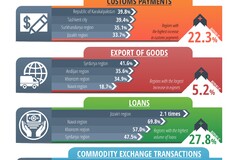Analysis of business activity is monthly calculated by CERR on the basis of operational data (monitoring in all regions of the republic, according to the data of the State Customs Committee, the State Tax Committee, the Central Bank and the UzEx).
The monitoring results showed that the volume of tax revenues of the republic in March this year increased by 9.8% compared to the same period last year.
At the same time, a significant increase in tax revenues was recorded in the Jizzakh (by 39.5%), Tashkent (by 27.9%), Syrdarya (by 26.9%), Samarkand (by 24.1%) and Navoi (by 23.4%) regions, in the Republic of Karakalpakstan (by 16.7%) and Tashkent (by 26.3%).
In the context of certain types of taxes, the revenue structure has changed mainly due to the growth in the number of economic entities. So for the month their number increased by 12.4% compared to the same period last year. In terms of tax revenue sources, VAT increased by 11%, income tax by 26%, property tax by 40% and land tax by 28%, maintaining growth until the end of the month.
Receipts on customs payments for the analyzed period increased by 22.3% compared to the same period in 2022. The largest increase in customs receipts was observed in Surkhandarya (by 35.1%), Jizzakh (by 33.7%), Samarkand (by 32.8%), Tashkent (by 29.1%) and Ferghana (by 23.0) regions, and in the Republic of Karakalpakstan (by 39.8%) and Tashkent (by 39.4%).
The increase in customs revenues was mainly due to an increase in imports by almost 25% compared to the same period last year due to the following types of products: transport equipment and its components, technical equipment, electrical equipment and its components, food and petroleum products.
The volume of exports of goods has increased by 5.2% since the beginning of the year compared to the same period last year. Export growth was observed in Syrdarya (by 41.6%), Andijan (by 35.6%), Khorezm (by 34.9%), Navoi (by 18.7%) and Kashkadarya (by 16.6%) regions, and in Tashkent (by 12.1%).
The increase in Uzbekistan's exports is explained by the growing growth rates of exports of food products, industrial goods, chemicals and agri-food products.
A decrease in exports was noted in Ferghana (by 23.3%), Tashkent (by 7.7%), Bukhara (by 6.9%), Jizzakh (by 6.3%), Surkhandarya (by 5.3%) and Samarkand (by 4.0%) regions, in the Republic of Karakalpakstan (by 15.2%).
The decline in exports in the Fergana and Jizzakh regions is associated with a reduction in yarn exports, in the Tashkent region with a reduction in exports of metals and products made from them, in the Bukhara region with the direction of cotton fiber to the domestic market and a reduction in exports of petroleum products, in the Surkhandarya region – a reduction in exports of yarn and textile products, in the Samarkand region – a reduction in yarn exports and fruit and vegetable products, in the Republic of Karakalpakstan – a reduction in the export of plastics and products made of them and yarn.
The volume of loans issued by commercial banks in the period from January 1 to March 31 this year increased by 27.8% compared to the same period last year.
A significant increase in the issuance of loans was noted in the Jizzakh (by 114.6%), Navoi (by 69.8%) Khorezm (by 57.0%), Syrdarya (by 47.5%), Kashkadarya (by 40.3%) regions, and in Tashkent (by 35.7%).
The volume of transactions on the UzEx for the analyzed period increased by 17.6%. A significant increase in exchange activity is observed in Kashkadarya (by 71.2%), Syrdarya (by 62.7%), Samarkand (by 40.3%) and Namangan (by 33.2%) regions, in the Republic of Karakalpakstan (by 34.2%) and Tashkent (by 11.0%).
The growth in the volume of transactions in these regions is ensured by increasing the sale of goods such as cotton fiber, wheat flour, wheat, mineral fertilizers, technical seeds, automobile gasoline, diesel fuel, liquefied gas, construction and household materials, sugar, rolled ferrous and non-ferrous metals, polyethylene, etc.
During the analyzed period, 23,761 new economic entities were created, the largest number of which were registered in Ferghana (2,243), Kashkadarya (2,175), Samarkand (2,092), Tashkent (1,938), Bukhara (1,574), regions and in Tashkent (4,250).
Mukhammadjon Rashidov, CERR






















leave a comment